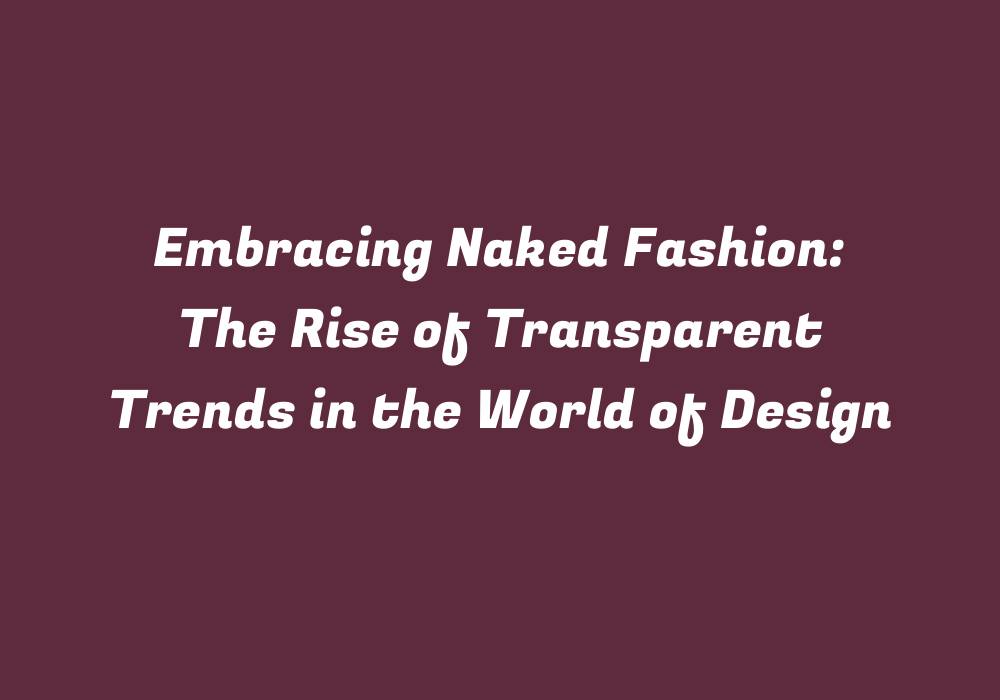Introduction
Fashion is a realm that continually evolves, with new trends and styles emerging every day. From the glamorous runways of Paris to the bustling streets of Tokyo, there is always something fresh to be discovered. One particular trend has been gaining significant attention in recent years: naked fashion or transparent design. This article will delve into the origins and growth of this concept, exploring its impact on various industries and examining its future potential.
The Birth of Transparent Trends
While the term “naked fashion” may have gained momentum recently, it was first conceived in the 1970s. This trend was led by avant-garde designers like Issey Miyake and Yohji Yamamoto, who used sheer materials and see-through fabrics to push boundaries in their designs. The concept of transparency in fashion became more widespread in the 2000s when designers like Alexander McQueen incorporated sheer garments into his runway shows.
Embracing Naked Fashion: A Global Phenomenon
The appeal of transparent design has transcended regional boundaries and has been embraced by different cultures around the world. In Europe, where fashion is often associated with self-expression and individuality, designers have incorporated sheer materials and innovative cuts to create unique pieces that showcase both body shape and inner beauty.
In Asia, designers such as Korean fashion designer Lee Hae-young and Japanese designer Yumi Katsura have contributed to the popularity of transparent garments, blurring the lines between tradition and modernity. Their collections often feature traditional elements woven into contemporary silhouettes with a strong emphasis on transparency.
North American designers like Jeremy Scott have also dabbled in transparent trends, creating head-turning runway looks that incorporate sheer materials and innovative construction techniques. This style has become increasingly popular among celebrities and influencers who use it to make bold statements at red carpet events and fashion shows.
The Impact on Fashion Industry and Society
As the naked fashion trend continues its ascent, it’s not just the design world that is taking notice. The ripple effect of this trend has led to discussions around body positivity, sustainability, and gender equality in the fashion industry. By encouraging designers to think beyond traditional garment construction, transparent designs are challenging the conventional perception of beauty and body image.
Body Positivity: One of the most significant impacts of naked fashion is its role in promoting diversity and inclusivity. Transparent materials and unique cuts can draw attention away from perceived flaws or imperfections, enabling individuals to feel confident in their bodies. This trend is also empowering people to embrace their natural beauty without succumbing to societal pressure to conform to a particular body type or standard of beauty.
Sustainability: By utilizing sheer materials, designers are able to create stunning garments with less fabric waste and fewer resources required for manufacturing. This shift in the fashion industry toward eco-conscious design is not only good for our planet but can also positively impact consumer buying habits, encouraging people to make more sustainable choices when purchasing clothing items.
Gender Equality: Naked fashion transcends gender boundaries by creating pieces that can be worn by individuals of any gender identity or expression. Transparent materials and innovative designs allow designers to create pieces that can cater to a diverse range of body shapes, sizes, and gender presentations without confining themselves within the traditional binary of masculine and feminine aesthetics.
The Future of Naked Fashion
As the naked fashion trend continues to grow in popularity, it’s apparent that this concept is here to stay. Transparent design will undoubtedly influence the future direction of the fashion industry by pushing boundaries and encouraging designers to explore innovative construction techniques and materials. With an increased focus on sustainability and inclusivity, this emerging trend has the potential to reshape the way we approach and consume fashion in the coming years.
In conclusion, naked fashion is more than just a temporary fad; it represents a movement that aims to transform the conventional paradigm of beauty, body image, and sustainability in the world of design. As this trend gains momentum around the globe, its impact on society will continue to evolve, leading to a more inclusive and eco-conscious fashion landscape for generations to come.
